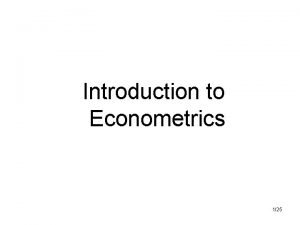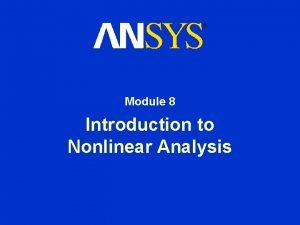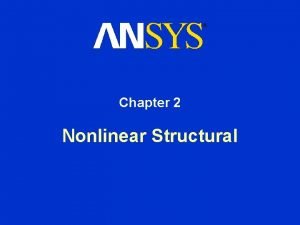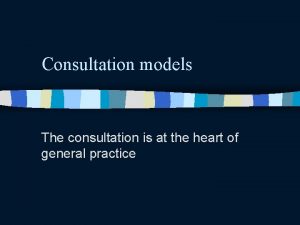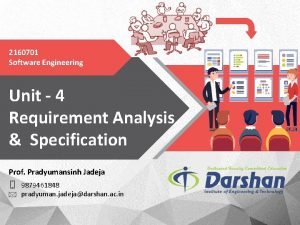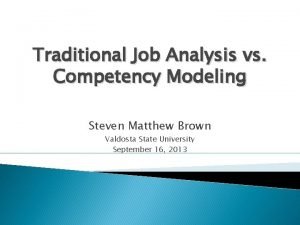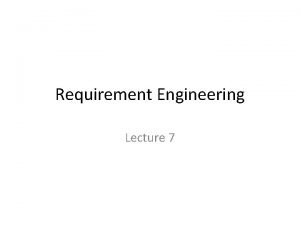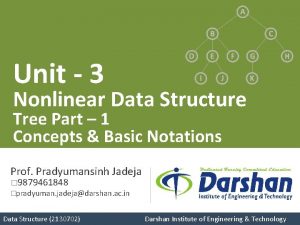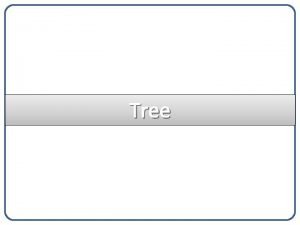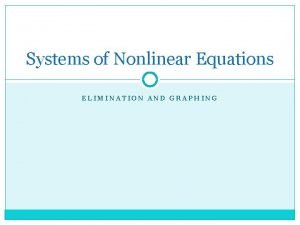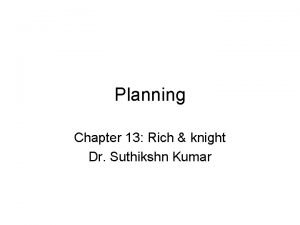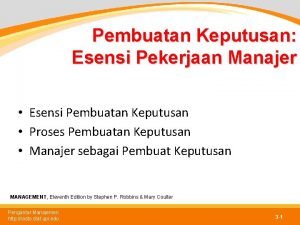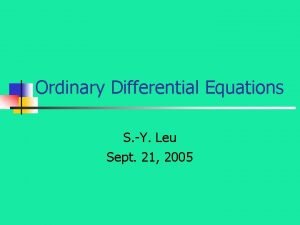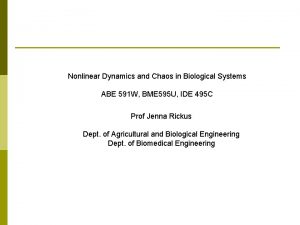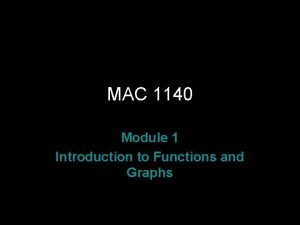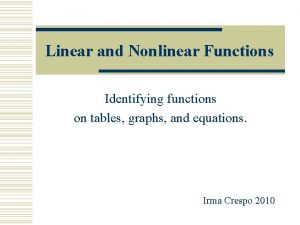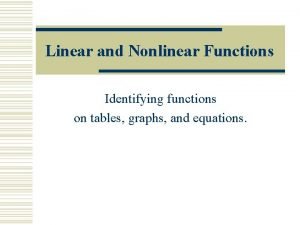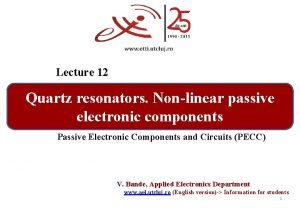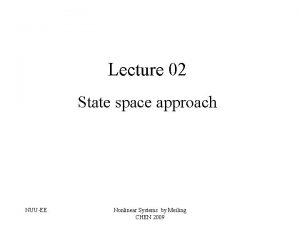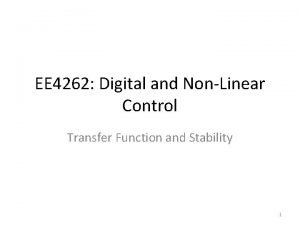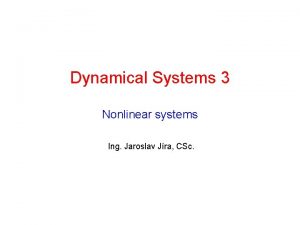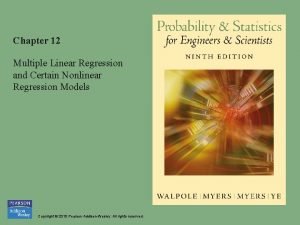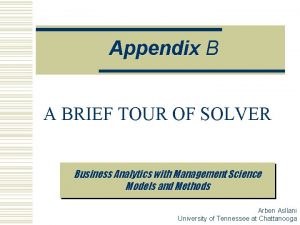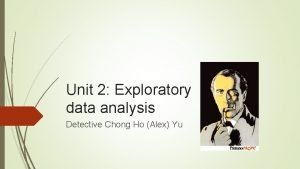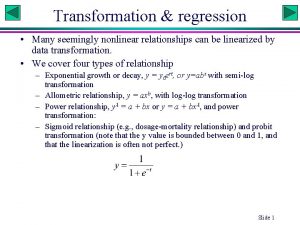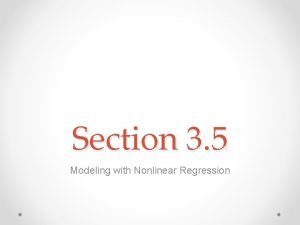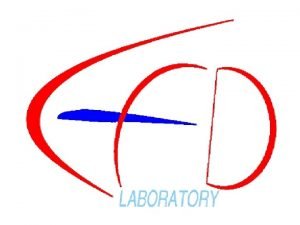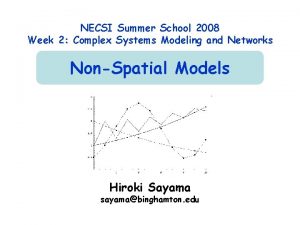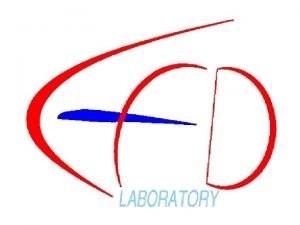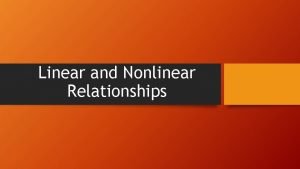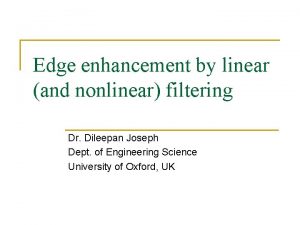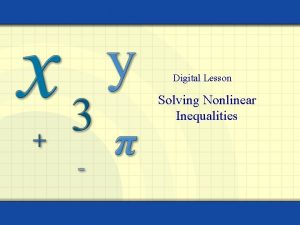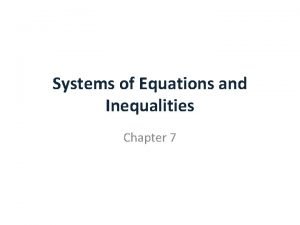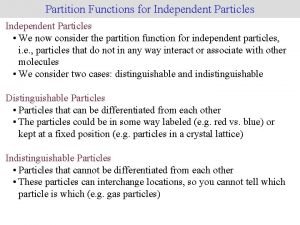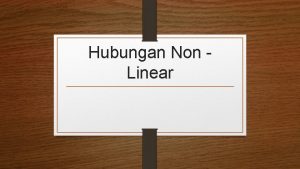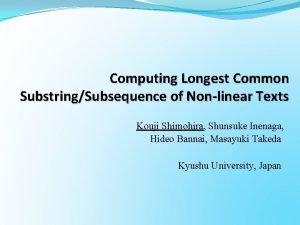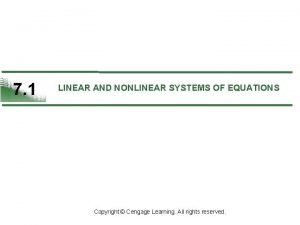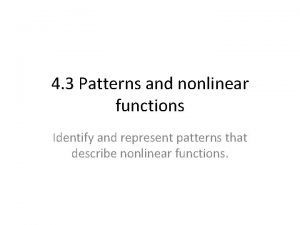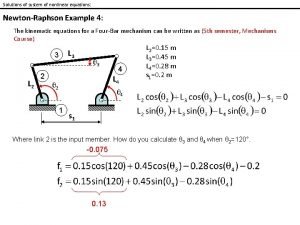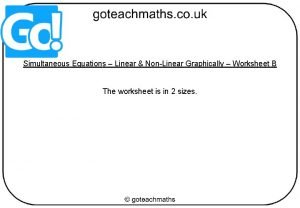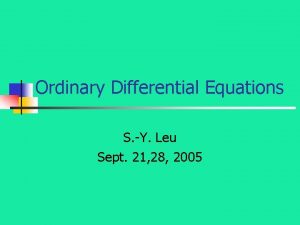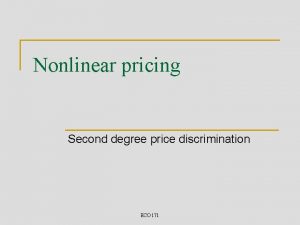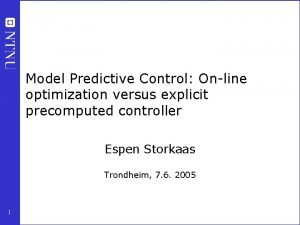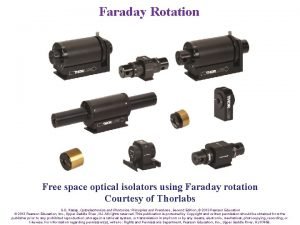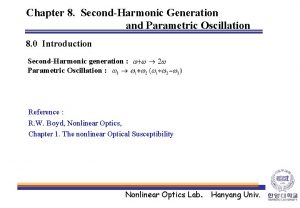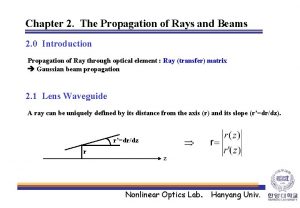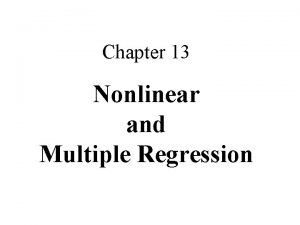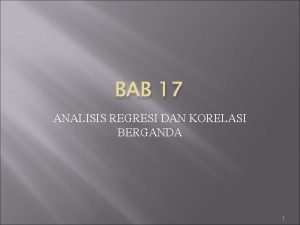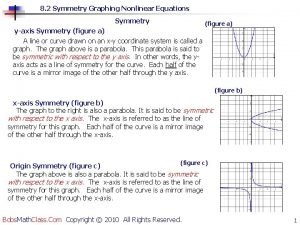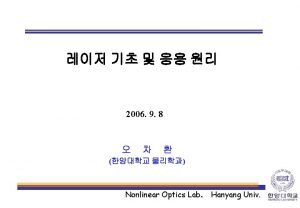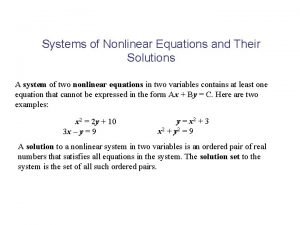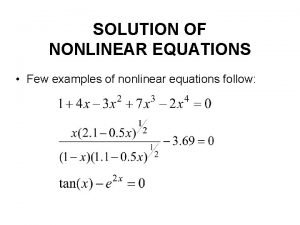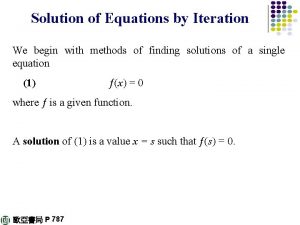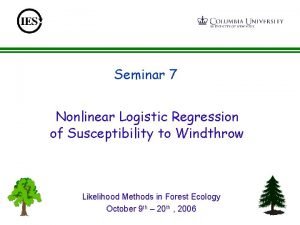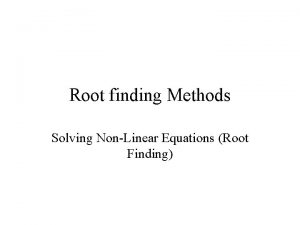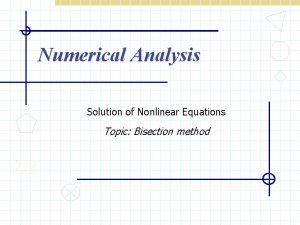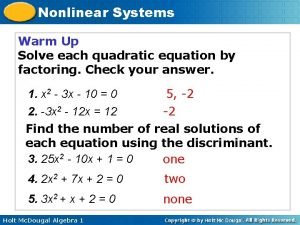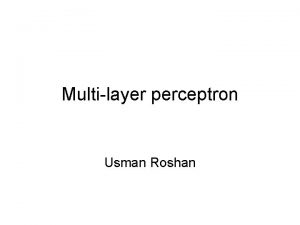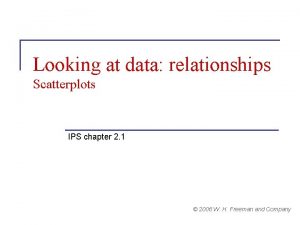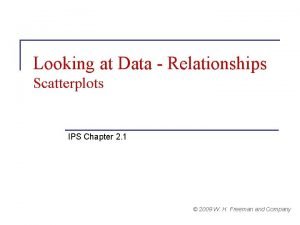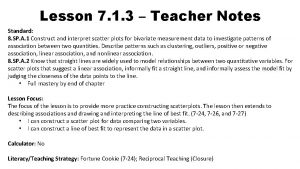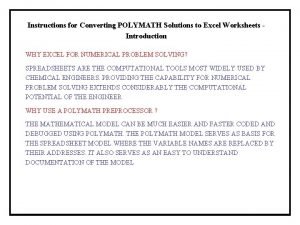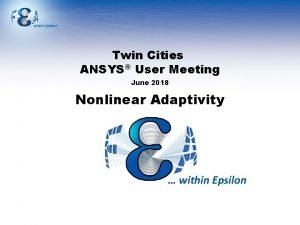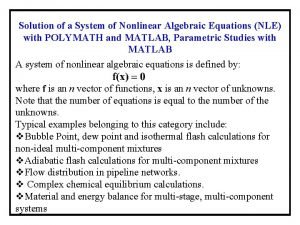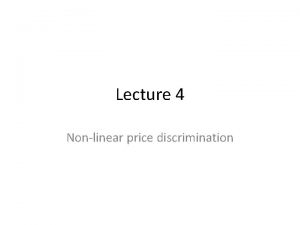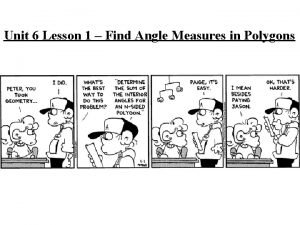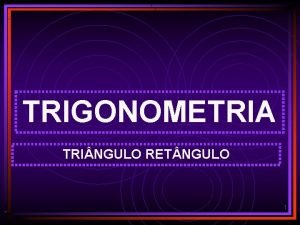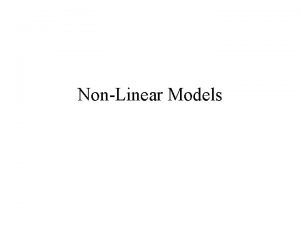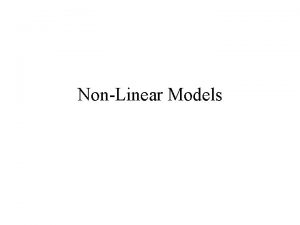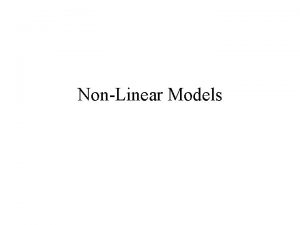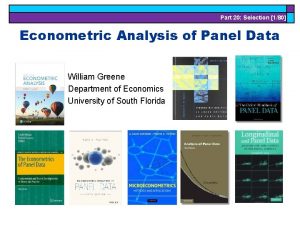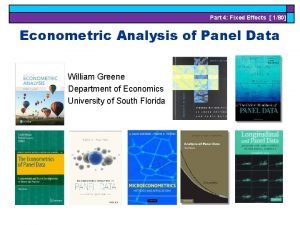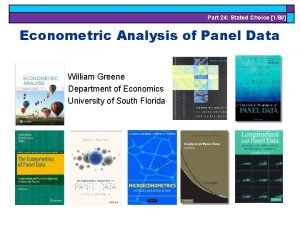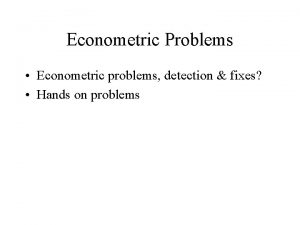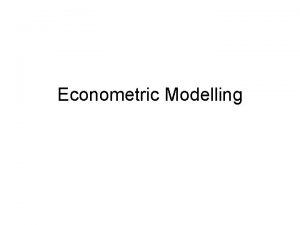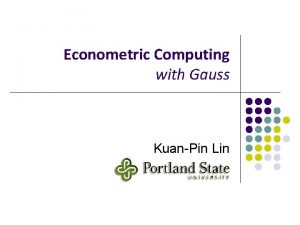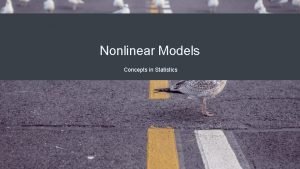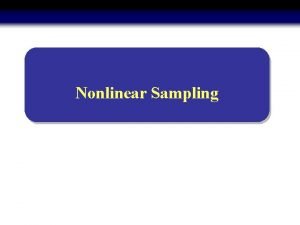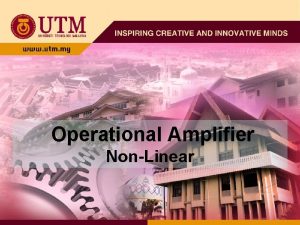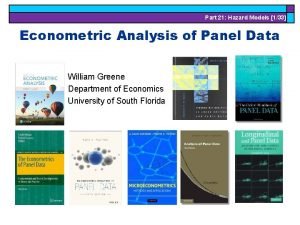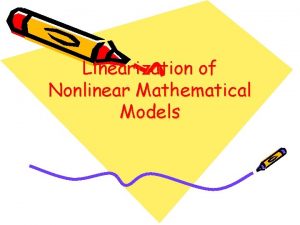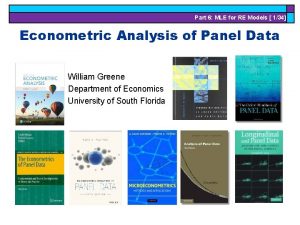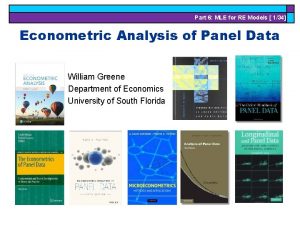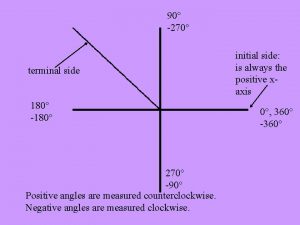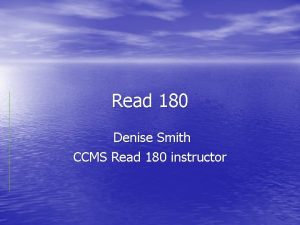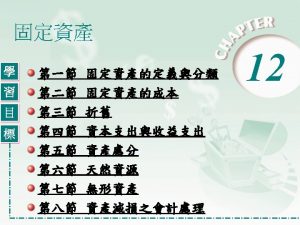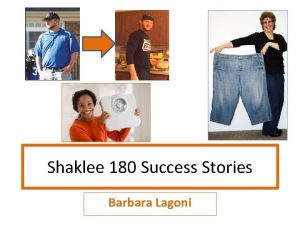Part 14 Nonlinear Models 180 Econometric Analysis of
![Part 14: Nonlinear Models [1/80] Econometric Analysis of Panel Data William Greene Department of Part 14: Nonlinear Models [1/80] Econometric Analysis of Panel Data William Greene Department of](https://slidetodoc.com/presentation_image/4363b1050ded5b300e01ac7a2c91d819/image-1.jpg)
![Part 14: Nonlinear Models [2/80] Nonlinear Models o o Nonlinear Models Estimation Theory for Part 14: Nonlinear Models [2/80] Nonlinear Models o o Nonlinear Models Estimation Theory for](https://slidetodoc.com/presentation_image/4363b1050ded5b300e01ac7a2c91d819/image-2.jpg)
![Part 14: Nonlinear Models [3/80] What is a ‘Model? ’ o o o Purely Part 14: Nonlinear Models [3/80] What is a ‘Model? ’ o o o Purely](https://slidetodoc.com/presentation_image/4363b1050ded5b300e01ac7a2c91d819/image-3.jpg)
![Part 14: Nonlinear Models [4/80] What is a Nonlinear Model? o o Model: E[g(y)|x] Part 14: Nonlinear Models [4/80] What is a Nonlinear Model? o o Model: E[g(y)|x]](https://slidetodoc.com/presentation_image/4363b1050ded5b300e01ac7a2c91d819/image-4.jpg)
![Part 14: Nonlinear Models [5/80] What is an Estimator? o o o Point and Part 14: Nonlinear Models [5/80] What is an Estimator? o o o Point and](https://slidetodoc.com/presentation_image/4363b1050ded5b300e01ac7a2c91d819/image-5.jpg)
![Part 14: Nonlinear Models [6/80] Parameters o o Model parameters – features of the Part 14: Nonlinear Models [6/80] Parameters o o Model parameters – features of the](https://slidetodoc.com/presentation_image/4363b1050ded5b300e01ac7a2c91d819/image-6.jpg)
![Part 14: Nonlinear Models [7/80] M Estimation Classical estimation method Part 14: Nonlinear Models [7/80] M Estimation Classical estimation method](https://slidetodoc.com/presentation_image/4363b1050ded5b300e01ac7a2c91d819/image-7.jpg)
![Part 14: Nonlinear Models [8/80] An Analogy Principle for M Estimation Part 14: Nonlinear Models [8/80] An Analogy Principle for M Estimation](https://slidetodoc.com/presentation_image/4363b1050ded5b300e01ac7a2c91d819/image-8.jpg)
![Part 14: Nonlinear Models [9/80] Estimation Part 14: Nonlinear Models [9/80] Estimation](https://slidetodoc.com/presentation_image/4363b1050ded5b300e01ac7a2c91d819/image-9.jpg)
![Part 14: Nonlinear Models [10/80] (1) The Parameters Are Identified Part 14: Nonlinear Models [10/80] (1) The Parameters Are Identified](https://slidetodoc.com/presentation_image/4363b1050ded5b300e01ac7a2c91d819/image-10.jpg)
![Part 14: Nonlinear Models [11/80] (2) Continuity of the Criterion Part 14: Nonlinear Models [11/80] (2) Continuity of the Criterion](https://slidetodoc.com/presentation_image/4363b1050ded5b300e01ac7a2c91d819/image-11.jpg)
![Part 14: Nonlinear Models [12/80] Consistency Part 14: Nonlinear Models [12/80] Consistency](https://slidetodoc.com/presentation_image/4363b1050ded5b300e01ac7a2c91d819/image-12.jpg)
![Part 14: Nonlinear Models [13/80] Asymptotic Normality of M Estimators Part 14: Nonlinear Models [13/80] Asymptotic Normality of M Estimators](https://slidetodoc.com/presentation_image/4363b1050ded5b300e01ac7a2c91d819/image-13.jpg)
![Part 14: Nonlinear Models [14/80] Estimating the Asymptotic Variance Part 14: Nonlinear Models [14/80] Estimating the Asymptotic Variance](https://slidetodoc.com/presentation_image/4363b1050ded5b300e01ac7a2c91d819/image-14.jpg)
![Part 14: Nonlinear Models [15/80] Nonlinear Least Squares Part 14: Nonlinear Models [15/80] Nonlinear Least Squares](https://slidetodoc.com/presentation_image/4363b1050ded5b300e01ac7a2c91d819/image-15.jpg)
![Part 14: Nonlinear Models [16/80] Application - Income German Health Care Usage Data, 7, Part 14: Nonlinear Models [16/80] Application - Income German Health Care Usage Data, 7,](https://slidetodoc.com/presentation_image/4363b1050ded5b300e01ac7a2c91d819/image-16.jpg)
![Part 14: Nonlinear Models [17/80] Income Data Part 14: Nonlinear Models [17/80] Income Data](https://slidetodoc.com/presentation_image/4363b1050ded5b300e01ac7a2c91d819/image-17.jpg)
![Part 14: Nonlinear Models [18/80] Exponential Model Part 14: Nonlinear Models [18/80] Exponential Model](https://slidetodoc.com/presentation_image/4363b1050ded5b300e01ac7a2c91d819/image-18.jpg)
![Part 14: Nonlinear Models [19/80] Conventional Variance Estimator Part 14: Nonlinear Models [19/80] Conventional Variance Estimator](https://slidetodoc.com/presentation_image/4363b1050ded5b300e01ac7a2c91d819/image-19.jpg)
![Part 14: Nonlinear Models [20/80] Variance Estimator for the M Estimator Part 14: Nonlinear Models [20/80] Variance Estimator for the M Estimator](https://slidetodoc.com/presentation_image/4363b1050ded5b300e01ac7a2c91d819/image-20.jpg)
![Part 14: Nonlinear Models [21/80] Computing NLS Reject; Calc ; Nlsq ; ; Name Part 14: Nonlinear Models [21/80] Computing NLS Reject; Calc ; Nlsq ; ; Name](https://slidetodoc.com/presentation_image/4363b1050ded5b300e01ac7a2c91d819/image-21.jpg)
![Part 14: Nonlinear Models [22/80] Iterations Part 14: Nonlinear Models [22/80] Iterations](https://slidetodoc.com/presentation_image/4363b1050ded5b300e01ac7a2c91d819/image-22.jpg)
![Part 14: Nonlinear Models [23/80] NLS Estimates with Different Variance Estimators Part 14: Nonlinear Models [23/80] NLS Estimates with Different Variance Estimators](https://slidetodoc.com/presentation_image/4363b1050ded5b300e01ac7a2c91d819/image-23.jpg)
![Part 14: Nonlinear Models [24/80] Hypothesis Tests for M Estimation Part 14: Nonlinear Models [24/80] Hypothesis Tests for M Estimation](https://slidetodoc.com/presentation_image/4363b1050ded5b300e01ac7a2c91d819/image-24.jpg)
![Part 14: Nonlinear Models [25/80] Wald Test Part 14: Nonlinear Models [25/80] Wald Test](https://slidetodoc.com/presentation_image/4363b1050ded5b300e01ac7a2c91d819/image-25.jpg)
![Part 14: Nonlinear Models [26/80] Change in the Criterion Function Part 14: Nonlinear Models [26/80] Change in the Criterion Function](https://slidetodoc.com/presentation_image/4363b1050ded5b300e01ac7a2c91d819/image-26.jpg)
![Part 14: Nonlinear Models [27/80] Score Test Part 14: Nonlinear Models [27/80] Score Test](https://slidetodoc.com/presentation_image/4363b1050ded5b300e01ac7a2c91d819/image-27.jpg)
![Part 14: Nonlinear Models [28/80] Exponential Model Part 14: Nonlinear Models [28/80] Exponential Model](https://slidetodoc.com/presentation_image/4363b1050ded5b300e01ac7a2c91d819/image-28.jpg)
![Part 14: Nonlinear Models [29/80] Wald Test Calc Nlsq ; b 0=log(xbr(hhninc))$ ; lhs Part 14: Nonlinear Models [29/80] Wald Test Calc Nlsq ; b 0=log(xbr(hhninc))$ ; lhs](https://slidetodoc.com/presentation_image/4363b1050ded5b300e01ac7a2c91d819/image-29.jpg)
![Part 14: Nonlinear Models [30/80] Change in Function Calc ; b 0 = log(xbr(hhninc)) Part 14: Nonlinear Models [30/80] Change in Function Calc ; b 0 = log(xbr(hhninc))](https://slidetodoc.com/presentation_image/4363b1050ded5b300e01ac7a2c91d819/image-30.jpg)
![Part 14: Nonlinear Models [31/80] Constrained Estimation Was 763. 767 Part 14: Nonlinear Models [31/80] Constrained Estimation Was 763. 767](https://slidetodoc.com/presentation_image/4363b1050ded5b300e01ac7a2c91d819/image-31.jpg)
![Part 14: Nonlinear Models [32/80] LM Test Part 14: Nonlinear Models [32/80] LM Test](https://slidetodoc.com/presentation_image/4363b1050ded5b300e01ac7a2c91d819/image-32.jpg)
![Part 14: Nonlinear Models [33/80] LM Test Namelist; Nlsq ; ; ; Create ; Part 14: Nonlinear Models [33/80] LM Test Namelist; Nlsq ; ; ; Create ;](https://slidetodoc.com/presentation_image/4363b1050ded5b300e01ac7a2c91d819/image-33.jpg)
![Part 14: Nonlinear Models [34/80] Maximum Likelihood Estimation o o Fully parametric estimation. Density Part 14: Nonlinear Models [34/80] Maximum Likelihood Estimation o o Fully parametric estimation. Density](https://slidetodoc.com/presentation_image/4363b1050ded5b300e01ac7a2c91d819/image-34.jpg)
![Part 14: Nonlinear Models [35/80] The Likelihood Function Part 14: Nonlinear Models [35/80] The Likelihood Function](https://slidetodoc.com/presentation_image/4363b1050ded5b300e01ac7a2c91d819/image-35.jpg)
![Part 14: Nonlinear Models [36/80] Consistency and Asymptotic Normality of the MLE o o Part 14: Nonlinear Models [36/80] Consistency and Asymptotic Normality of the MLE o o](https://slidetodoc.com/presentation_image/4363b1050ded5b300e01ac7a2c91d819/image-36.jpg)
![Part 14: Nonlinear Models [37/80] Asymptotic Variance of the MLE Part 14: Nonlinear Models [37/80] Asymptotic Variance of the MLE](https://slidetodoc.com/presentation_image/4363b1050ded5b300e01ac7a2c91d819/image-37.jpg)
![Part 14: Nonlinear Models [38/80] The Information Matrix Equality Part 14: Nonlinear Models [38/80] The Information Matrix Equality](https://slidetodoc.com/presentation_image/4363b1050ded5b300e01ac7a2c91d819/image-38.jpg)
![Part 14: Nonlinear Models [39/80] Three Variance Estimators o o o Negative inverse of Part 14: Nonlinear Models [39/80] Three Variance Estimators o o o Negative inverse of](https://slidetodoc.com/presentation_image/4363b1050ded5b300e01ac7a2c91d819/image-39.jpg)
![Part 14: Nonlinear Models [40/80] Asymptotic Efficiency o o M estimator based on the Part 14: Nonlinear Models [40/80] Asymptotic Efficiency o o M estimator based on the](https://slidetodoc.com/presentation_image/4363b1050ded5b300e01ac7a2c91d819/image-40.jpg)
![Part 14: Nonlinear Models [41/80] Invariance Part 14: Nonlinear Models [41/80] Invariance](https://slidetodoc.com/presentation_image/4363b1050ded5b300e01ac7a2c91d819/image-41.jpg)
![Part 14: Nonlinear Models [42/80] Log Likelihood Function Part 14: Nonlinear Models [42/80] Log Likelihood Function](https://slidetodoc.com/presentation_image/4363b1050ded5b300e01ac7a2c91d819/image-42.jpg)
![Part 14: Nonlinear Models [43/80] Application: Exponential Regression – MLE and NLS MLE assumes Part 14: Nonlinear Models [43/80] Application: Exponential Regression – MLE and NLS MLE assumes](https://slidetodoc.com/presentation_image/4363b1050ded5b300e01ac7a2c91d819/image-43.jpg)
![Part 14: Nonlinear Models [44/80] Variance Estimators Part 14: Nonlinear Models [44/80] Variance Estimators](https://slidetodoc.com/presentation_image/4363b1050ded5b300e01ac7a2c91d819/image-44.jpg)
![Part 14: Nonlinear Models [45/80] Three Variance Estimators Part 14: Nonlinear Models [45/80] Three Variance Estimators](https://slidetodoc.com/presentation_image/4363b1050ded5b300e01ac7a2c91d819/image-45.jpg)
![Part 14: Nonlinear Models [46/80] Robust (? ) Estimator Part 14: Nonlinear Models [46/80] Robust (? ) Estimator](https://slidetodoc.com/presentation_image/4363b1050ded5b300e01ac7a2c91d819/image-46.jpg)
![Part 14: Nonlinear Models [47/80] Variance Estimators Loglinear ; Lhs=hhninc; Rhs=x ; Model = Part 14: Nonlinear Models [47/80] Variance Estimators Loglinear ; Lhs=hhninc; Rhs=x ; Model =](https://slidetodoc.com/presentation_image/4363b1050ded5b300e01ac7a2c91d819/image-47.jpg)
![Part 14: Nonlinear Models [48/80] Robust Standard Errors Exponential (Loglinear) Regression Model ----+----------------------------------| Clustered Part 14: Nonlinear Models [48/80] Robust Standard Errors Exponential (Loglinear) Regression Model ----+----------------------------------| Clustered](https://slidetodoc.com/presentation_image/4363b1050ded5b300e01ac7a2c91d819/image-48.jpg)
![Part 14: Nonlinear Models [49/80] Hypothesis Tests o Trinity of tests for nested hypotheses Part 14: Nonlinear Models [49/80] Hypothesis Tests o Trinity of tests for nested hypotheses](https://slidetodoc.com/presentation_image/4363b1050ded5b300e01ac7a2c91d819/image-49.jpg)
![Part 14: Nonlinear Models [50/80] Example Exponential vs. Gamma Exponential: P = 1 P>1 Part 14: Nonlinear Models [50/80] Example Exponential vs. Gamma Exponential: P = 1 P>1](https://slidetodoc.com/presentation_image/4363b1050ded5b300e01ac7a2c91d819/image-50.jpg)
![Part 14: Nonlinear Models [51/80] Log Likelihood Part 14: Nonlinear Models [51/80] Log Likelihood](https://slidetodoc.com/presentation_image/4363b1050ded5b300e01ac7a2c91d819/image-51.jpg)
![Part 14: Nonlinear Models [52/80] Estimated Gamma Model Part 14: Nonlinear Models [52/80] Estimated Gamma Model](https://slidetodoc.com/presentation_image/4363b1050ded5b300e01ac7a2c91d819/image-52.jpg)
![Part 14: Nonlinear Models [53/80] Testing P = 1 o o Wald: W = Part 14: Nonlinear Models [53/80] Testing P = 1 o o Wald: W =](https://slidetodoc.com/presentation_image/4363b1050ded5b300e01ac7a2c91d819/image-53.jpg)
![Part 14: Nonlinear Models [54/80] Derivatives for the LM Test Part 14: Nonlinear Models [54/80] Derivatives for the LM Test](https://slidetodoc.com/presentation_image/4363b1050ded5b300e01ac7a2c91d819/image-54.jpg)
![Part 14: Nonlinear Models [55/80] Score Test Part 14: Nonlinear Models [55/80] Score Test](https://slidetodoc.com/presentation_image/4363b1050ded5b300e01ac7a2c91d819/image-55.jpg)
![Part 14: Nonlinear Models [56/80] Calculated LM Statistic Loglinear ; Lhs = hhninc ; Part 14: Nonlinear Models [56/80] Calculated LM Statistic Loglinear ; Lhs = hhninc ;](https://slidetodoc.com/presentation_image/4363b1050ded5b300e01ac7a2c91d819/image-56.jpg)
![Part 14: Nonlinear Models [57/80] Clustered Data Part 14: Nonlinear Models [57/80] Clustered Data](https://slidetodoc.com/presentation_image/4363b1050ded5b300e01ac7a2c91d819/image-57.jpg)
![Part 14: Nonlinear Models [58/80] Inference with ‘Clustering’ Part 14: Nonlinear Models [58/80] Inference with ‘Clustering’](https://slidetodoc.com/presentation_image/4363b1050ded5b300e01ac7a2c91d819/image-58.jpg)
![Part 14: Nonlinear Models [59/80] Cluster Estimation Part 14: Nonlinear Models [59/80] Cluster Estimation](https://slidetodoc.com/presentation_image/4363b1050ded5b300e01ac7a2c91d819/image-59.jpg)
![Part 14: Nonlinear Models [60/80] On Clustering o o The theory is rather loose. Part 14: Nonlinear Models [60/80] On Clustering o o The theory is rather loose.](https://slidetodoc.com/presentation_image/4363b1050ded5b300e01ac7a2c91d819/image-60.jpg)
![Part 14: Nonlinear Models [61/80] ‘Robust’ Estimation o o If the model is misspecified Part 14: Nonlinear Models [61/80] ‘Robust’ Estimation o o If the model is misspecified](https://slidetodoc.com/presentation_image/4363b1050ded5b300e01ac7a2c91d819/image-61.jpg)
![Part 14: Nonlinear Models [62/80] Part 14: Nonlinear Models [62/80]](https://slidetodoc.com/presentation_image/4363b1050ded5b300e01ac7a2c91d819/image-62.jpg)
![Part 14: Nonlinear Models [63/80] From Cameron and Miller: Practitioner’s Guide… Clustering Part 14: Nonlinear Models [63/80] From Cameron and Miller: Practitioner’s Guide… Clustering](https://slidetodoc.com/presentation_image/4363b1050ded5b300e01ac7a2c91d819/image-63.jpg)
![Part 14: Nonlinear Models [64/80] A Concentrated Log Likelihood Part 14: Nonlinear Models [64/80] A Concentrated Log Likelihood](https://slidetodoc.com/presentation_image/4363b1050ded5b300e01ac7a2c91d819/image-64.jpg)
![Part 14: Nonlinear Models [65/80] Normal Linear Regression Part 14: Nonlinear Models [65/80] Normal Linear Regression](https://slidetodoc.com/presentation_image/4363b1050ded5b300e01ac7a2c91d819/image-65.jpg)
![Part 14: Nonlinear Models [66/80] Two Step Estimation and Murphy/Topel Part 14: Nonlinear Models [66/80] Two Step Estimation and Murphy/Topel](https://slidetodoc.com/presentation_image/4363b1050ded5b300e01ac7a2c91d819/image-66.jpg)
![Part 14: Nonlinear Models [67/80] Two Step Estimation Part 14: Nonlinear Models [67/80] Two Step Estimation](https://slidetodoc.com/presentation_image/4363b1050ded5b300e01ac7a2c91d819/image-67.jpg)
![Part 14: Nonlinear Models [68/80] Part 14: Nonlinear Models [68/80]](https://slidetodoc.com/presentation_image/4363b1050ded5b300e01ac7a2c91d819/image-68.jpg)
![Part 14: Nonlinear Models [69/80] Murphy-Topel - 1 Part 14: Nonlinear Models [69/80] Murphy-Topel - 1](https://slidetodoc.com/presentation_image/4363b1050ded5b300e01ac7a2c91d819/image-69.jpg)
![Part 14: Nonlinear Models [70/80] Murphy-Topel - 2 Part 14: Nonlinear Models [70/80] Murphy-Topel - 2](https://slidetodoc.com/presentation_image/4363b1050ded5b300e01ac7a2c91d819/image-70.jpg)
![Part 14: Nonlinear Models [71/80] Optimization - Algorithms Part 14: Nonlinear Models [71/80] Optimization - Algorithms](https://slidetodoc.com/presentation_image/4363b1050ded5b300e01ac7a2c91d819/image-71.jpg)
![Part 14: Nonlinear Models [72/80] Optimization Part 14: Nonlinear Models [72/80] Optimization](https://slidetodoc.com/presentation_image/4363b1050ded5b300e01ac7a2c91d819/image-72.jpg)
![Part 14: Nonlinear Models [73/80] Algorithms Part 14: Nonlinear Models [73/80] Algorithms](https://slidetodoc.com/presentation_image/4363b1050ded5b300e01ac7a2c91d819/image-73.jpg)
![Part 14: Nonlinear Models [74/80] Line Search Methods Part 14: Nonlinear Models [74/80] Line Search Methods](https://slidetodoc.com/presentation_image/4363b1050ded5b300e01ac7a2c91d819/image-74.jpg)
![Part 14: Nonlinear Models [75/80] Quasi-Newton Methods Part 14: Nonlinear Models [75/80] Quasi-Newton Methods](https://slidetodoc.com/presentation_image/4363b1050ded5b300e01ac7a2c91d819/image-75.jpg)
![Part 14: Nonlinear Models [76/80] Stopping Rule Part 14: Nonlinear Models [76/80] Stopping Rule](https://slidetodoc.com/presentation_image/4363b1050ded5b300e01ac7a2c91d819/image-76.jpg)
![Part 14: Nonlinear Models [77/80] Start value for constant is log (mean HHNINC) Start Part 14: Nonlinear Models [77/80] Start value for constant is log (mean HHNINC) Start](https://slidetodoc.com/presentation_image/4363b1050ded5b300e01ac7a2c91d819/image-77.jpg)
![Part 14: Nonlinear Models [78/80] Part 14: Nonlinear Models [78/80]](https://slidetodoc.com/presentation_image/4363b1050ded5b300e01ac7a2c91d819/image-78.jpg)
![Part 14: Nonlinear Models [79/80] Part 14: Nonlinear Models [79/80]](https://slidetodoc.com/presentation_image/4363b1050ded5b300e01ac7a2c91d819/image-79.jpg)
![Part 14: Nonlinear Models [80/80] Part 14: Nonlinear Models [80/80]](https://slidetodoc.com/presentation_image/4363b1050ded5b300e01ac7a2c91d819/image-80.jpg)
![Part 14: Nonlinear Models [81/80] Appendix Part 14: Nonlinear Models [81/80] Appendix](https://slidetodoc.com/presentation_image/4363b1050ded5b300e01ac7a2c91d819/image-81.jpg)
![Part 14: Nonlinear Models [82/80] The Conditional Mean Function Part 14: Nonlinear Models [82/80] The Conditional Mean Function](https://slidetodoc.com/presentation_image/4363b1050ded5b300e01ac7a2c91d819/image-82.jpg)
![Part 14: Nonlinear Models [83/80] Asymptotic Normality of M Estimators Part 14: Nonlinear Models [83/80] Asymptotic Normality of M Estimators](https://slidetodoc.com/presentation_image/4363b1050ded5b300e01ac7a2c91d819/image-83.jpg)
![Part 14: Nonlinear Models [84/80] Asymptotic Normality Part 14: Nonlinear Models [84/80] Asymptotic Normality](https://slidetodoc.com/presentation_image/4363b1050ded5b300e01ac7a2c91d819/image-84.jpg)
![Part 14: Nonlinear Models [85/80] Asymptotic Normality Part 14: Nonlinear Models [85/80] Asymptotic Normality](https://slidetodoc.com/presentation_image/4363b1050ded5b300e01ac7a2c91d819/image-85.jpg)
![Part 14: Nonlinear Models [86/80] Asymptotic Variance Part 14: Nonlinear Models [86/80] Asymptotic Variance](https://slidetodoc.com/presentation_image/4363b1050ded5b300e01ac7a2c91d819/image-86.jpg)
![Part 14: Nonlinear Models [87/80] Conditional and Unconditional Likelihood Part 14: Nonlinear Models [87/80] Conditional and Unconditional Likelihood](https://slidetodoc.com/presentation_image/4363b1050ded5b300e01ac7a2c91d819/image-87.jpg)
![Part 14: Nonlinear Models [88/80] Concentrated Log Likelihood Part 14: Nonlinear Models [88/80] Concentrated Log Likelihood](https://slidetodoc.com/presentation_image/4363b1050ded5b300e01ac7a2c91d819/image-88.jpg)
![Part 14: Nonlinear Models [89/80] ‘Regularity’ Conditions for MLE o o o Conditions for Part 14: Nonlinear Models [89/80] ‘Regularity’ Conditions for MLE o o o Conditions for](https://slidetodoc.com/presentation_image/4363b1050ded5b300e01ac7a2c91d819/image-89.jpg)
![Part 14: Nonlinear Models [90/80] GMM Estimation Part 14: Nonlinear Models [90/80] GMM Estimation](https://slidetodoc.com/presentation_image/4363b1050ded5b300e01ac7a2c91d819/image-90.jpg)
![Part 14: Nonlinear Models [91/80] GMM Estimation-1 o o GMM is broader than M Part 14: Nonlinear Models [91/80] GMM Estimation-1 o o GMM is broader than M](https://slidetodoc.com/presentation_image/4363b1050ded5b300e01ac7a2c91d819/image-91.jpg)
![Part 14: Nonlinear Models [92/80] GMM Estimation - 2 Part 14: Nonlinear Models [92/80] GMM Estimation - 2](https://slidetodoc.com/presentation_image/4363b1050ded5b300e01ac7a2c91d819/image-92.jpg)
![Part 14: Nonlinear Models [93/80] ML and M Estimation Part 14: Nonlinear Models [93/80] ML and M Estimation](https://slidetodoc.com/presentation_image/4363b1050ded5b300e01ac7a2c91d819/image-93.jpg)
- Slides: 93
![Part 14 Nonlinear Models 180 Econometric Analysis of Panel Data William Greene Department of Part 14: Nonlinear Models [1/80] Econometric Analysis of Panel Data William Greene Department of](https://slidetodoc.com/presentation_image/4363b1050ded5b300e01ac7a2c91d819/image-1.jpg)
Part 14: Nonlinear Models [1/80] Econometric Analysis of Panel Data William Greene Department of Economics University of South Florida
![Part 14 Nonlinear Models 280 Nonlinear Models o o Nonlinear Models Estimation Theory for Part 14: Nonlinear Models [2/80] Nonlinear Models o o Nonlinear Models Estimation Theory for](https://slidetodoc.com/presentation_image/4363b1050ded5b300e01ac7a2c91d819/image-2.jpg)
Part 14: Nonlinear Models [2/80] Nonlinear Models o o Nonlinear Models Estimation Theory for Nonlinear Models n n n Estimators Properties M Estimation o o n GMM Estimation o o o Minimum Distance Estimation Minimum Chi-square Estimation Computation – Nonlinear Optimization n n o Nonlinear Least Squares Maximum Likelihood Estimation Nonlinear Least Squares Newton-like Algorithms; Gradient Methods (Background: JW, Chapters 12 -14, Greene, Chapters 12 -14, App. E)
![Part 14 Nonlinear Models 380 What is a Model o o o Purely Part 14: Nonlinear Models [3/80] What is a ‘Model? ’ o o o Purely](https://slidetodoc.com/presentation_image/4363b1050ded5b300e01ac7a2c91d819/image-3.jpg)
Part 14: Nonlinear Models [3/80] What is a ‘Model? ’ o o o Purely verbal description of a phenomenon Unconditional ‘characteristics’ of a population Conditional moments: E[g(y)|x]: median, mean, variance, quantile, correlations, probabilities… Conditional probabilities and densities Conditional means and regressions Fully parametric and semiparametric specifications n n n Parametric specification: Known up to parameter θ Parameter spaces Conditional means: E[y|x] = m(x, θ)
![Part 14 Nonlinear Models 480 What is a Nonlinear Model o o Model Egyx Part 14: Nonlinear Models [4/80] What is a Nonlinear Model? o o Model: E[g(y)|x]](https://slidetodoc.com/presentation_image/4363b1050ded5b300e01ac7a2c91d819/image-4.jpg)
Part 14: Nonlinear Models [4/80] What is a Nonlinear Model? o o Model: E[g(y)|x] = m(x, θ) Objective: n n o o Learn about θ from y, X Usually “estimate” θ Linear Model: Closed form; = h(y, X) Nonlinear Model: “Any model that is not linear” n n Not wrt m(x, θ). E. g. , y=exp(θ’x + ε) Wrt estimator: Implicitly defined. h(y, X, E[y|x]= exp(θ’x) )=0, E. g. ,
![Part 14 Nonlinear Models 580 What is an Estimator o o o Point and Part 14: Nonlinear Models [5/80] What is an Estimator? o o o Point and](https://slidetodoc.com/presentation_image/4363b1050ded5b300e01ac7a2c91d819/image-5.jpg)
Part 14: Nonlinear Models [5/80] What is an Estimator? o o o Point and Interval Set estimation: some subset of RK Classical and Bayesian
![Part 14 Nonlinear Models 680 Parameters o o Model parameters features of the Part 14: Nonlinear Models [6/80] Parameters o o Model parameters – features of the](https://slidetodoc.com/presentation_image/4363b1050ded5b300e01ac7a2c91d819/image-6.jpg)
Part 14: Nonlinear Models [6/80] Parameters o o Model parameters – features of the population The “true” parameter(s)
![Part 14 Nonlinear Models 780 M Estimation Classical estimation method Part 14: Nonlinear Models [7/80] M Estimation Classical estimation method](https://slidetodoc.com/presentation_image/4363b1050ded5b300e01ac7a2c91d819/image-7.jpg)
Part 14: Nonlinear Models [7/80] M Estimation Classical estimation method
![Part 14 Nonlinear Models 880 An Analogy Principle for M Estimation Part 14: Nonlinear Models [8/80] An Analogy Principle for M Estimation](https://slidetodoc.com/presentation_image/4363b1050ded5b300e01ac7a2c91d819/image-8.jpg)
Part 14: Nonlinear Models [8/80] An Analogy Principle for M Estimation
![Part 14 Nonlinear Models 980 Estimation Part 14: Nonlinear Models [9/80] Estimation](https://slidetodoc.com/presentation_image/4363b1050ded5b300e01ac7a2c91d819/image-9.jpg)
Part 14: Nonlinear Models [9/80] Estimation
![Part 14 Nonlinear Models 1080 1 The Parameters Are Identified Part 14: Nonlinear Models [10/80] (1) The Parameters Are Identified](https://slidetodoc.com/presentation_image/4363b1050ded5b300e01ac7a2c91d819/image-10.jpg)
Part 14: Nonlinear Models [10/80] (1) The Parameters Are Identified
![Part 14 Nonlinear Models 1180 2 Continuity of the Criterion Part 14: Nonlinear Models [11/80] (2) Continuity of the Criterion](https://slidetodoc.com/presentation_image/4363b1050ded5b300e01ac7a2c91d819/image-11.jpg)
Part 14: Nonlinear Models [11/80] (2) Continuity of the Criterion
![Part 14 Nonlinear Models 1280 Consistency Part 14: Nonlinear Models [12/80] Consistency](https://slidetodoc.com/presentation_image/4363b1050ded5b300e01ac7a2c91d819/image-12.jpg)
Part 14: Nonlinear Models [12/80] Consistency
![Part 14 Nonlinear Models 1380 Asymptotic Normality of M Estimators Part 14: Nonlinear Models [13/80] Asymptotic Normality of M Estimators](https://slidetodoc.com/presentation_image/4363b1050ded5b300e01ac7a2c91d819/image-13.jpg)
Part 14: Nonlinear Models [13/80] Asymptotic Normality of M Estimators
![Part 14 Nonlinear Models 1480 Estimating the Asymptotic Variance Part 14: Nonlinear Models [14/80] Estimating the Asymptotic Variance](https://slidetodoc.com/presentation_image/4363b1050ded5b300e01ac7a2c91d819/image-14.jpg)
Part 14: Nonlinear Models [14/80] Estimating the Asymptotic Variance
![Part 14 Nonlinear Models 1580 Nonlinear Least Squares Part 14: Nonlinear Models [15/80] Nonlinear Least Squares](https://slidetodoc.com/presentation_image/4363b1050ded5b300e01ac7a2c91d819/image-15.jpg)
Part 14: Nonlinear Models [15/80] Nonlinear Least Squares
![Part 14 Nonlinear Models 1680 Application Income German Health Care Usage Data 7 Part 14: Nonlinear Models [16/80] Application - Income German Health Care Usage Data, 7,](https://slidetodoc.com/presentation_image/4363b1050ded5b300e01ac7a2c91d819/image-16.jpg)
Part 14: Nonlinear Models [16/80] Application - Income German Health Care Usage Data, 7, 293 Individuals, Varying Numbers of Periods Variables in the file are Data downloaded from Journal of Applied Econometrics Archive. This is an unbalanced panel with 7, 293 individuals. They can be used for regression, count models, binary choice, ordered choice, and bivariate binary choice. This is a large data set. There altogether 27, 326 observations. The number of observations ranges from 1 to 7. (Frequencies are: 1=1525, 2=2158, 3=825, 4=926, 5=1051, 6=1000, 7=987). HHNINC = household nominal monthly net income in German marks / 10000. (4 observations with income=0 were dropped) HHKIDS = children under age 16 in the household = 1; otherwise = 0 EDUC = years of schooling AGE = age in years
![Part 14 Nonlinear Models 1780 Income Data Part 14: Nonlinear Models [17/80] Income Data](https://slidetodoc.com/presentation_image/4363b1050ded5b300e01ac7a2c91d819/image-17.jpg)
Part 14: Nonlinear Models [17/80] Income Data
![Part 14 Nonlinear Models 1880 Exponential Model Part 14: Nonlinear Models [18/80] Exponential Model](https://slidetodoc.com/presentation_image/4363b1050ded5b300e01ac7a2c91d819/image-18.jpg)
Part 14: Nonlinear Models [18/80] Exponential Model
![Part 14 Nonlinear Models 1980 Conventional Variance Estimator Part 14: Nonlinear Models [19/80] Conventional Variance Estimator](https://slidetodoc.com/presentation_image/4363b1050ded5b300e01ac7a2c91d819/image-19.jpg)
Part 14: Nonlinear Models [19/80] Conventional Variance Estimator
![Part 14 Nonlinear Models 2080 Variance Estimator for the M Estimator Part 14: Nonlinear Models [20/80] Variance Estimator for the M Estimator](https://slidetodoc.com/presentation_image/4363b1050ded5b300e01ac7a2c91d819/image-20.jpg)
Part 14: Nonlinear Models [20/80] Variance Estimator for the M Estimator
![Part 14 Nonlinear Models 2180 Computing NLS Reject Calc Nlsq Name Part 14: Nonlinear Models [21/80] Computing NLS Reject; Calc ; Nlsq ; ; Name](https://slidetodoc.com/presentation_image/4363b1050ded5b300e01ac7a2c91d819/image-21.jpg)
Part 14: Nonlinear Models [21/80] Computing NLS Reject; Calc ; Nlsq ; ; Name ; Create; ; Matrix; hhninc=0$ b 0=log(xbr(hhninc))$ lhs = hhninc fcn = exp(a 0+a 1*educ+a 2*married+a 3*age) start = b 0, 0, 0, 0 labels = a 0, a 1, a 2, a 3$ x = one, educ, married, age$ thetai = exp(x'b); ei = hhninc-thetai gi=ei*thetai ; hi = thetai*thetai$ var. M = <x'[hi] x> * x'[gi^2]x * <x'[hi] x> $ stat(b, varm, x)$
![Part 14 Nonlinear Models 2280 Iterations Part 14: Nonlinear Models [22/80] Iterations](https://slidetodoc.com/presentation_image/4363b1050ded5b300e01ac7a2c91d819/image-22.jpg)
Part 14: Nonlinear Models [22/80] Iterations
![Part 14 Nonlinear Models 2380 NLS Estimates with Different Variance Estimators Part 14: Nonlinear Models [23/80] NLS Estimates with Different Variance Estimators](https://slidetodoc.com/presentation_image/4363b1050ded5b300e01ac7a2c91d819/image-23.jpg)
Part 14: Nonlinear Models [23/80] NLS Estimates with Different Variance Estimators
![Part 14 Nonlinear Models 2480 Hypothesis Tests for M Estimation Part 14: Nonlinear Models [24/80] Hypothesis Tests for M Estimation](https://slidetodoc.com/presentation_image/4363b1050ded5b300e01ac7a2c91d819/image-24.jpg)
Part 14: Nonlinear Models [24/80] Hypothesis Tests for M Estimation
![Part 14 Nonlinear Models 2580 Wald Test Part 14: Nonlinear Models [25/80] Wald Test](https://slidetodoc.com/presentation_image/4363b1050ded5b300e01ac7a2c91d819/image-25.jpg)
Part 14: Nonlinear Models [25/80] Wald Test
![Part 14 Nonlinear Models 2680 Change in the Criterion Function Part 14: Nonlinear Models [26/80] Change in the Criterion Function](https://slidetodoc.com/presentation_image/4363b1050ded5b300e01ac7a2c91d819/image-26.jpg)
Part 14: Nonlinear Models [26/80] Change in the Criterion Function
![Part 14 Nonlinear Models 2780 Score Test Part 14: Nonlinear Models [27/80] Score Test](https://slidetodoc.com/presentation_image/4363b1050ded5b300e01ac7a2c91d819/image-27.jpg)
Part 14: Nonlinear Models [27/80] Score Test
![Part 14 Nonlinear Models 2880 Exponential Model Part 14: Nonlinear Models [28/80] Exponential Model](https://slidetodoc.com/presentation_image/4363b1050ded5b300e01ac7a2c91d819/image-28.jpg)
Part 14: Nonlinear Models [28/80] Exponential Model
![Part 14 Nonlinear Models 2980 Wald Test Calc Nlsq b 0logxbrhhninc lhs Part 14: Nonlinear Models [29/80] Wald Test Calc Nlsq ; b 0=log(xbr(hhninc))$ ; lhs](https://slidetodoc.com/presentation_image/4363b1050ded5b300e01ac7a2c91d819/image-29.jpg)
Part 14: Nonlinear Models [29/80] Wald Test Calc Nlsq ; b 0=log(xbr(hhninc))$ ; lhs = hhninc ; fcn = exp(a 0+a 1*educ+a 2*married+a 3*age) ; start = b 0, 0, 0, 0 ; labels = a 0, a 1, a 2, a 3$ Matrix ; List ; R = [0, 1, 0, 0 / 0, 0, 1, 0 / 0, 0, 0, 1] ; c = R*b ; Vc = R*Varb*R’ ; Wald = c’ <VC> c $ Matrix R has 3 rows and 4 columns. 0. 00000 1. 00000 0. 000000 1. 00000 0. 000000 0. 00000 1. 00000 Matrix C has 3 rows and 1 columns. 0. 05471 0. 23761 0. 00081 Matrix VC has 3 rows and 3 columns. . 1053686 D-05. 4530603 D-06. 3649631 D-07. 4530603 D-06. 5859546 D-04 -. 3565863 D-06. 3649631 D-07 -. 3565863 D-06. 6940296 D-07 Matrix WALD = 3627. 17514
![Part 14 Nonlinear Models 3080 Change in Function Calc b 0 logxbrhhninc Part 14: Nonlinear Models [30/80] Change in Function Calc ; b 0 = log(xbr(hhninc))](https://slidetodoc.com/presentation_image/4363b1050ded5b300e01ac7a2c91d819/image-30.jpg)
Part 14: Nonlinear Models [30/80] Change in Function Calc ; b 0 = log(xbr(hhninc)) $ Nlsq ; lhs = hhninc ; labels = a 0, a 1, a 2, a 3 ; start = b 0, 0, 0, 0 ; fcn = exp(a 0+a 1*educ+a 2*married+a 3*age)$ Calc ; qbar = sumsqdev/n $ Nlsq ; lhs = hhninc ; labels = a 0, a 1, a 2, a 3 ; start = b 0, 0, 0, 0 ; fix = a 1, a 2, a 3 ; fcn = exp(a 0+a 1*educ+a 2*married+a 3*age)$ Calc ; qbar 0 = sumsqdev/n $ Calc ; cm = 2*n*(qbar 0 – qbar) $ (Sumsqdev = 763. 767; Sumsqdev_0 = 854. 682) 2(854. 682 – 763. 767) = 181. 83
![Part 14 Nonlinear Models 3180 Constrained Estimation Was 763 767 Part 14: Nonlinear Models [31/80] Constrained Estimation Was 763. 767](https://slidetodoc.com/presentation_image/4363b1050ded5b300e01ac7a2c91d819/image-31.jpg)
Part 14: Nonlinear Models [31/80] Constrained Estimation Was 763. 767
![Part 14 Nonlinear Models 3280 LM Test Part 14: Nonlinear Models [32/80] LM Test](https://slidetodoc.com/presentation_image/4363b1050ded5b300e01ac7a2c91d819/image-32.jpg)
Part 14: Nonlinear Models [32/80] LM Test
![Part 14 Nonlinear Models 3380 LM Test Namelist Nlsq Create Part 14: Nonlinear Models [33/80] LM Test Namelist; Nlsq ; ; ; Create ;](https://slidetodoc.com/presentation_image/4363b1050ded5b300e01ac7a2c91d819/image-33.jpg)
Part 14: Nonlinear Models [33/80] LM Test Namelist; Nlsq ; ; ; Create ; Matrix ; ; Matrix LM x = one, educ, married, age$ lhs = hhninc ; labels = a 0, a 1, a 2, a 3 start = b 0, 0, 0, 0 ; fix = a 1, a 2, a 3 fcn = exp(a 0+a 1*educ+a 2*married+a 3*age)$ thetai = exp(x'b) ei = hhninc - thetai$ gi = ei*thetai ; gi 2 = gi*gi $ list LM = gi’x * <x'[gi 2]x> * x’gi $ 1 +-------1| 1915. 03286
![Part 14 Nonlinear Models 3480 Maximum Likelihood Estimation o o Fully parametric estimation Density Part 14: Nonlinear Models [34/80] Maximum Likelihood Estimation o o Fully parametric estimation. Density](https://slidetodoc.com/presentation_image/4363b1050ded5b300e01ac7a2c91d819/image-34.jpg)
Part 14: Nonlinear Models [34/80] Maximum Likelihood Estimation o o Fully parametric estimation. Density of yi is fully specified The likelihood function = the joint density of the observed random variables. Example: density for the exponential model
![Part 14 Nonlinear Models 3580 The Likelihood Function Part 14: Nonlinear Models [35/80] The Likelihood Function](https://slidetodoc.com/presentation_image/4363b1050ded5b300e01ac7a2c91d819/image-35.jpg)
Part 14: Nonlinear Models [35/80] The Likelihood Function
![Part 14 Nonlinear Models 3680 Consistency and Asymptotic Normality of the MLE o o Part 14: Nonlinear Models [36/80] Consistency and Asymptotic Normality of the MLE o o](https://slidetodoc.com/presentation_image/4363b1050ded5b300e01ac7a2c91d819/image-36.jpg)
Part 14: Nonlinear Models [36/80] Consistency and Asymptotic Normality of the MLE o o o Conditions are identical to those for M estimation Terms in proofs are log density and its derivatives Nothing new is needed. n Law of large numbers n Lindberg-Feller central limit theorem applies to derivatives of the log likelihood.
![Part 14 Nonlinear Models 3780 Asymptotic Variance of the MLE Part 14: Nonlinear Models [37/80] Asymptotic Variance of the MLE](https://slidetodoc.com/presentation_image/4363b1050ded5b300e01ac7a2c91d819/image-37.jpg)
Part 14: Nonlinear Models [37/80] Asymptotic Variance of the MLE
![Part 14 Nonlinear Models 3880 The Information Matrix Equality Part 14: Nonlinear Models [38/80] The Information Matrix Equality](https://slidetodoc.com/presentation_image/4363b1050ded5b300e01ac7a2c91d819/image-38.jpg)
Part 14: Nonlinear Models [38/80] The Information Matrix Equality
![Part 14 Nonlinear Models 3980 Three Variance Estimators o o o Negative inverse of Part 14: Nonlinear Models [39/80] Three Variance Estimators o o o Negative inverse of](https://slidetodoc.com/presentation_image/4363b1050ded5b300e01ac7a2c91d819/image-39.jpg)
Part 14: Nonlinear Models [39/80] Three Variance Estimators o o o Negative inverse of expected second derivatives matrix. (Usually not known) Negative inverse of actual second derivatives matrix. Inverse of variance of first derivatives
![Part 14 Nonlinear Models 4080 Asymptotic Efficiency o o M estimator based on the Part 14: Nonlinear Models [40/80] Asymptotic Efficiency o o M estimator based on the](https://slidetodoc.com/presentation_image/4363b1050ded5b300e01ac7a2c91d819/image-40.jpg)
Part 14: Nonlinear Models [40/80] Asymptotic Efficiency o o M estimator based on the conditional mean is semiparametric. Not necessarily efficient. MLE is fully parametric. It is efficient among all consistent and asymptotically normal estimators when the density is as specified. This is the Cramer-Rao bound. Note the implied comparison to nonlinear least squares for the exponential regression model.
![Part 14 Nonlinear Models 4180 Invariance Part 14: Nonlinear Models [41/80] Invariance](https://slidetodoc.com/presentation_image/4363b1050ded5b300e01ac7a2c91d819/image-41.jpg)
Part 14: Nonlinear Models [41/80] Invariance
![Part 14 Nonlinear Models 4280 Log Likelihood Function Part 14: Nonlinear Models [42/80] Log Likelihood Function](https://slidetodoc.com/presentation_image/4363b1050ded5b300e01ac7a2c91d819/image-42.jpg)
Part 14: Nonlinear Models [42/80] Log Likelihood Function
![Part 14 Nonlinear Models 4380 Application Exponential Regression MLE and NLS MLE assumes Part 14: Nonlinear Models [43/80] Application: Exponential Regression – MLE and NLS MLE assumes](https://slidetodoc.com/presentation_image/4363b1050ded5b300e01ac7a2c91d819/image-43.jpg)
Part 14: Nonlinear Models [43/80] Application: Exponential Regression – MLE and NLS MLE assumes E[y|x] = exp(-β′x) – Note sign reversal.
![Part 14 Nonlinear Models 4480 Variance Estimators Part 14: Nonlinear Models [44/80] Variance Estimators](https://slidetodoc.com/presentation_image/4363b1050ded5b300e01ac7a2c91d819/image-44.jpg)
Part 14: Nonlinear Models [44/80] Variance Estimators
![Part 14 Nonlinear Models 4580 Three Variance Estimators Part 14: Nonlinear Models [45/80] Three Variance Estimators](https://slidetodoc.com/presentation_image/4363b1050ded5b300e01ac7a2c91d819/image-45.jpg)
Part 14: Nonlinear Models [45/80] Three Variance Estimators
![Part 14 Nonlinear Models 4680 Robust Estimator Part 14: Nonlinear Models [46/80] Robust (? ) Estimator](https://slidetodoc.com/presentation_image/4363b1050ded5b300e01ac7a2c91d819/image-46.jpg)
Part 14: Nonlinear Models [46/80] Robust (? ) Estimator
![Part 14 Nonlinear Models 4780 Variance Estimators Loglinear Lhshhninc Rhsx Model Part 14: Nonlinear Models [47/80] Variance Estimators Loglinear ; Lhs=hhninc; Rhs=x ; Model =](https://slidetodoc.com/presentation_image/4363b1050ded5b300e01ac7a2c91d819/image-47.jpg)
Part 14: Nonlinear Models [47/80] Variance Estimators Loglinear ; Lhs=hhninc; Rhs=x ; Model = Exponential create; thetai=exp(x'b); hi=hhninc*thetai; gi 2=(hi-1)^2$ matr; he=<x'x>; ha=<x'[hi]x>; bhhh=<x'[gi 2]x>$ matr; stat(b, ha); stat(b, he); stat(b, bhhh)$
![Part 14 Nonlinear Models 4880 Robust Standard Errors Exponential Loglinear Regression Model Clustered Part 14: Nonlinear Models [48/80] Robust Standard Errors Exponential (Loglinear) Regression Model ----+----------------------------------| Clustered](https://slidetodoc.com/presentation_image/4363b1050ded5b300e01ac7a2c91d819/image-48.jpg)
Part 14: Nonlinear Models [48/80] Robust Standard Errors Exponential (Loglinear) Regression Model ----+----------------------------------| Clustered Prob. 95% Confidence INCOME| Coefficient Std. Error z |z|>Z* Interval ----+----------------------------------|Parameters in conditional mean function. . . . Constant| -1. 82539***. 02113 -86. 37. 0000 -1. 86681 -1. 78397 EDUC|. 05544***. 00126 43. 90. 0000. 05296. 05791 MARRIED|. 23666***. 00833 28. 40. 0000. 22033. 25299 AGE| -. 00087***. 00027 -3. 20. 0014 -. 00141 -. 00034 ----+----------------------------------NOTICE: The standard errors go down. . . Standard errors clustered on Fixed (27326 clusters)
![Part 14 Nonlinear Models 4980 Hypothesis Tests o Trinity of tests for nested hypotheses Part 14: Nonlinear Models [49/80] Hypothesis Tests o Trinity of tests for nested hypotheses](https://slidetodoc.com/presentation_image/4363b1050ded5b300e01ac7a2c91d819/image-49.jpg)
Part 14: Nonlinear Models [49/80] Hypothesis Tests o Trinity of tests for nested hypotheses n n n o Wald Likelihood ratio Lagrange multiplier All as defined for the M estimators
![Part 14 Nonlinear Models 5080 Example Exponential vs Gamma Exponential P 1 P1 Part 14: Nonlinear Models [50/80] Example Exponential vs. Gamma Exponential: P = 1 P>1](https://slidetodoc.com/presentation_image/4363b1050ded5b300e01ac7a2c91d819/image-50.jpg)
Part 14: Nonlinear Models [50/80] Example Exponential vs. Gamma Exponential: P = 1 P>1
![Part 14 Nonlinear Models 5180 Log Likelihood Part 14: Nonlinear Models [51/80] Log Likelihood](https://slidetodoc.com/presentation_image/4363b1050ded5b300e01ac7a2c91d819/image-51.jpg)
Part 14: Nonlinear Models [51/80] Log Likelihood
![Part 14 Nonlinear Models 5280 Estimated Gamma Model Part 14: Nonlinear Models [52/80] Estimated Gamma Model](https://slidetodoc.com/presentation_image/4363b1050ded5b300e01ac7a2c91d819/image-52.jpg)
Part 14: Nonlinear Models [52/80] Estimated Gamma Model
![Part 14 Nonlinear Models 5380 Testing P 1 o o Wald W Part 14: Nonlinear Models [53/80] Testing P = 1 o o Wald: W =](https://slidetodoc.com/presentation_image/4363b1050ded5b300e01ac7a2c91d819/image-53.jpg)
Part 14: Nonlinear Models [53/80] Testing P = 1 o o Wald: W = (5. 10591 -1)2/. 042332 = 9408. 5 Likelihood Ratio: n n n o ln. L|(P=1)= 1539. 31 ln. L|P = 14240. 74 LR = 2(14240. 74 - 1539. 31)=25402. 86 Lagrange Multiplier…
![Part 14 Nonlinear Models 5480 Derivatives for the LM Test Part 14: Nonlinear Models [54/80] Derivatives for the LM Test](https://slidetodoc.com/presentation_image/4363b1050ded5b300e01ac7a2c91d819/image-54.jpg)
Part 14: Nonlinear Models [54/80] Derivatives for the LM Test
![Part 14 Nonlinear Models 5580 Score Test Part 14: Nonlinear Models [55/80] Score Test](https://slidetodoc.com/presentation_image/4363b1050ded5b300e01ac7a2c91d819/image-55.jpg)
Part 14: Nonlinear Models [55/80] Score Test
![Part 14 Nonlinear Models 5680 Calculated LM Statistic Loglinear Lhs hhninc Part 14: Nonlinear Models [56/80] Calculated LM Statistic Loglinear ; Lhs = hhninc ;](https://slidetodoc.com/presentation_image/4363b1050ded5b300e01ac7a2c91d819/image-56.jpg)
Part 14: Nonlinear Models [56/80] Calculated LM Statistic Loglinear ; Lhs = hhninc ; Rhs = x ; Model = Exponential $ Create; thetai=exp(x’b) ; gi=(hhninc*thetai – 1) $ Create; gpi=log(hhninc*thetai)-psi(1)$ Create; g 1 i=gi; g 2 i=gi*educ; g 3 i=gi*married; g 4 i=gi*age; g 5 i=gpi$ Namelist; ggi=g 1 i, g 2 i, g 3 i, g 4 i, g 5 i$ Matrix; list ; lm = 1'ggi * <ggi'ggi> * ggi'1 $ Matrix LM has 1 rows and 1 columns. 1 +-------1| 23468. 7 ? Use built-in procedure. ? LM is computed with actual Hessian instead of BHHH Loglinear ; Lhs = hhninc ; Rhs = x ; Model = Exponential $ logl; lhs=hhninc; rhs=x; model=gamma; start=b, 1; maxit=0 $ | LM Stat. at start values 9604. 33 |
![Part 14 Nonlinear Models 5780 Clustered Data Part 14: Nonlinear Models [57/80] Clustered Data](https://slidetodoc.com/presentation_image/4363b1050ded5b300e01ac7a2c91d819/image-57.jpg)
Part 14: Nonlinear Models [57/80] Clustered Data
![Part 14 Nonlinear Models 5880 Inference with Clustering Part 14: Nonlinear Models [58/80] Inference with ‘Clustering’](https://slidetodoc.com/presentation_image/4363b1050ded5b300e01ac7a2c91d819/image-58.jpg)
Part 14: Nonlinear Models [58/80] Inference with ‘Clustering’
![Part 14 Nonlinear Models 5980 Cluster Estimation Part 14: Nonlinear Models [59/80] Cluster Estimation](https://slidetodoc.com/presentation_image/4363b1050ded5b300e01ac7a2c91d819/image-59.jpg)
Part 14: Nonlinear Models [59/80] Cluster Estimation
![Part 14 Nonlinear Models 6080 On Clustering o o The theory is rather loose Part 14: Nonlinear Models [60/80] On Clustering o o The theory is rather loose.](https://slidetodoc.com/presentation_image/4363b1050ded5b300e01ac7a2c91d819/image-60.jpg)
Part 14: Nonlinear Models [60/80] On Clustering o o The theory is rather loose. That the marginals would be correctly specified while there is ‘correlation’ across observations is ambiguous It seems to work pretty well in practice (anyway) BUT… It does not imply that one can safely just pool the observations in a panel and ignore unobserved common effects.
![Part 14 Nonlinear Models 6180 Robust Estimation o o If the model is misspecified Part 14: Nonlinear Models [61/80] ‘Robust’ Estimation o o If the model is misspecified](https://slidetodoc.com/presentation_image/4363b1050ded5b300e01ac7a2c91d819/image-61.jpg)
Part 14: Nonlinear Models [61/80] ‘Robust’ Estimation o o If the model is misspecified in some way, then the information matrix equality does not hold. Assuming the estimator remains consistent, the appropriate asymptotic covariance matrix would be the ‘robust’ matrix, actually, the original one,
![Part 14 Nonlinear Models 6280 Part 14: Nonlinear Models [62/80]](https://slidetodoc.com/presentation_image/4363b1050ded5b300e01ac7a2c91d819/image-62.jpg)
Part 14: Nonlinear Models [62/80]
![Part 14 Nonlinear Models 6380 From Cameron and Miller Practitioners Guide Clustering Part 14: Nonlinear Models [63/80] From Cameron and Miller: Practitioner’s Guide… Clustering](https://slidetodoc.com/presentation_image/4363b1050ded5b300e01ac7a2c91d819/image-63.jpg)
Part 14: Nonlinear Models [63/80] From Cameron and Miller: Practitioner’s Guide… Clustering
![Part 14 Nonlinear Models 6480 A Concentrated Log Likelihood Part 14: Nonlinear Models [64/80] A Concentrated Log Likelihood](https://slidetodoc.com/presentation_image/4363b1050ded5b300e01ac7a2c91d819/image-64.jpg)
Part 14: Nonlinear Models [64/80] A Concentrated Log Likelihood
![Part 14 Nonlinear Models 6580 Normal Linear Regression Part 14: Nonlinear Models [65/80] Normal Linear Regression](https://slidetodoc.com/presentation_image/4363b1050ded5b300e01ac7a2c91d819/image-65.jpg)
Part 14: Nonlinear Models [65/80] Normal Linear Regression
![Part 14 Nonlinear Models 6680 Two Step Estimation and MurphyTopel Part 14: Nonlinear Models [66/80] Two Step Estimation and Murphy/Topel](https://slidetodoc.com/presentation_image/4363b1050ded5b300e01ac7a2c91d819/image-66.jpg)
Part 14: Nonlinear Models [66/80] Two Step Estimation and Murphy/Topel
![Part 14 Nonlinear Models 6780 Two Step Estimation Part 14: Nonlinear Models [67/80] Two Step Estimation](https://slidetodoc.com/presentation_image/4363b1050ded5b300e01ac7a2c91d819/image-67.jpg)
Part 14: Nonlinear Models [67/80] Two Step Estimation
![Part 14 Nonlinear Models 6880 Part 14: Nonlinear Models [68/80]](https://slidetodoc.com/presentation_image/4363b1050ded5b300e01ac7a2c91d819/image-68.jpg)
Part 14: Nonlinear Models [68/80]
![Part 14 Nonlinear Models 6980 MurphyTopel 1 Part 14: Nonlinear Models [69/80] Murphy-Topel - 1](https://slidetodoc.com/presentation_image/4363b1050ded5b300e01ac7a2c91d819/image-69.jpg)
Part 14: Nonlinear Models [69/80] Murphy-Topel - 1
![Part 14 Nonlinear Models 7080 MurphyTopel 2 Part 14: Nonlinear Models [70/80] Murphy-Topel - 2](https://slidetodoc.com/presentation_image/4363b1050ded5b300e01ac7a2c91d819/image-70.jpg)
Part 14: Nonlinear Models [70/80] Murphy-Topel - 2
![Part 14 Nonlinear Models 7180 Optimization Algorithms Part 14: Nonlinear Models [71/80] Optimization - Algorithms](https://slidetodoc.com/presentation_image/4363b1050ded5b300e01ac7a2c91d819/image-71.jpg)
Part 14: Nonlinear Models [71/80] Optimization - Algorithms
![Part 14 Nonlinear Models 7280 Optimization Part 14: Nonlinear Models [72/80] Optimization](https://slidetodoc.com/presentation_image/4363b1050ded5b300e01ac7a2c91d819/image-72.jpg)
Part 14: Nonlinear Models [72/80] Optimization
![Part 14 Nonlinear Models 7380 Algorithms Part 14: Nonlinear Models [73/80] Algorithms](https://slidetodoc.com/presentation_image/4363b1050ded5b300e01ac7a2c91d819/image-73.jpg)
Part 14: Nonlinear Models [73/80] Algorithms
![Part 14 Nonlinear Models 7480 Line Search Methods Part 14: Nonlinear Models [74/80] Line Search Methods](https://slidetodoc.com/presentation_image/4363b1050ded5b300e01ac7a2c91d819/image-74.jpg)
Part 14: Nonlinear Models [74/80] Line Search Methods
![Part 14 Nonlinear Models 7580 QuasiNewton Methods Part 14: Nonlinear Models [75/80] Quasi-Newton Methods](https://slidetodoc.com/presentation_image/4363b1050ded5b300e01ac7a2c91d819/image-75.jpg)
Part 14: Nonlinear Models [75/80] Quasi-Newton Methods
![Part 14 Nonlinear Models 7680 Stopping Rule Part 14: Nonlinear Models [76/80] Stopping Rule](https://slidetodoc.com/presentation_image/4363b1050ded5b300e01ac7a2c91d819/image-76.jpg)
Part 14: Nonlinear Models [76/80] Stopping Rule
![Part 14 Nonlinear Models 7780 Start value for constant is log mean HHNINC Start Part 14: Nonlinear Models [77/80] Start value for constant is log (mean HHNINC) Start](https://slidetodoc.com/presentation_image/4363b1050ded5b300e01ac7a2c91d819/image-77.jpg)
Part 14: Nonlinear Models [77/80] Start value for constant is log (mean HHNINC) Start value for P is 1 => exponential model.
![Part 14 Nonlinear Models 7880 Part 14: Nonlinear Models [78/80]](https://slidetodoc.com/presentation_image/4363b1050ded5b300e01ac7a2c91d819/image-78.jpg)
Part 14: Nonlinear Models [78/80]
![Part 14 Nonlinear Models 7980 Part 14: Nonlinear Models [79/80]](https://slidetodoc.com/presentation_image/4363b1050ded5b300e01ac7a2c91d819/image-79.jpg)
Part 14: Nonlinear Models [79/80]
![Part 14 Nonlinear Models 8080 Part 14: Nonlinear Models [80/80]](https://slidetodoc.com/presentation_image/4363b1050ded5b300e01ac7a2c91d819/image-80.jpg)
Part 14: Nonlinear Models [80/80]
![Part 14 Nonlinear Models 8180 Appendix Part 14: Nonlinear Models [81/80] Appendix](https://slidetodoc.com/presentation_image/4363b1050ded5b300e01ac7a2c91d819/image-81.jpg)
Part 14: Nonlinear Models [81/80] Appendix
![Part 14 Nonlinear Models 8280 The Conditional Mean Function Part 14: Nonlinear Models [82/80] The Conditional Mean Function](https://slidetodoc.com/presentation_image/4363b1050ded5b300e01ac7a2c91d819/image-82.jpg)
Part 14: Nonlinear Models [82/80] The Conditional Mean Function
![Part 14 Nonlinear Models 8380 Asymptotic Normality of M Estimators Part 14: Nonlinear Models [83/80] Asymptotic Normality of M Estimators](https://slidetodoc.com/presentation_image/4363b1050ded5b300e01ac7a2c91d819/image-83.jpg)
Part 14: Nonlinear Models [83/80] Asymptotic Normality of M Estimators
![Part 14 Nonlinear Models 8480 Asymptotic Normality Part 14: Nonlinear Models [84/80] Asymptotic Normality](https://slidetodoc.com/presentation_image/4363b1050ded5b300e01ac7a2c91d819/image-84.jpg)
Part 14: Nonlinear Models [84/80] Asymptotic Normality
![Part 14 Nonlinear Models 8580 Asymptotic Normality Part 14: Nonlinear Models [85/80] Asymptotic Normality](https://slidetodoc.com/presentation_image/4363b1050ded5b300e01ac7a2c91d819/image-85.jpg)
Part 14: Nonlinear Models [85/80] Asymptotic Normality
![Part 14 Nonlinear Models 8680 Asymptotic Variance Part 14: Nonlinear Models [86/80] Asymptotic Variance](https://slidetodoc.com/presentation_image/4363b1050ded5b300e01ac7a2c91d819/image-86.jpg)
Part 14: Nonlinear Models [86/80] Asymptotic Variance
![Part 14 Nonlinear Models 8780 Conditional and Unconditional Likelihood Part 14: Nonlinear Models [87/80] Conditional and Unconditional Likelihood](https://slidetodoc.com/presentation_image/4363b1050ded5b300e01ac7a2c91d819/image-87.jpg)
Part 14: Nonlinear Models [87/80] Conditional and Unconditional Likelihood
![Part 14 Nonlinear Models 8880 Concentrated Log Likelihood Part 14: Nonlinear Models [88/80] Concentrated Log Likelihood](https://slidetodoc.com/presentation_image/4363b1050ded5b300e01ac7a2c91d819/image-88.jpg)
Part 14: Nonlinear Models [88/80] Concentrated Log Likelihood
![Part 14 Nonlinear Models 8980 Regularity Conditions for MLE o o o Conditions for Part 14: Nonlinear Models [89/80] ‘Regularity’ Conditions for MLE o o o Conditions for](https://slidetodoc.com/presentation_image/4363b1050ded5b300e01ac7a2c91d819/image-89.jpg)
Part 14: Nonlinear Models [89/80] ‘Regularity’ Conditions for MLE o o o Conditions for the MLE to be consistent, etc. Augment the continuity and identification conditions for M estimation Regularity: n n n o Three times continuous differentiability of the log density Finite third moments of log density Conditions needed to obtain expected values of derivatives of log density are met. (See Greene (Chapter 14))
![Part 14 Nonlinear Models 9080 GMM Estimation Part 14: Nonlinear Models [90/80] GMM Estimation](https://slidetodoc.com/presentation_image/4363b1050ded5b300e01ac7a2c91d819/image-90.jpg)
Part 14: Nonlinear Models [90/80] GMM Estimation
![Part 14 Nonlinear Models 9180 GMM Estimation1 o o GMM is broader than M Part 14: Nonlinear Models [91/80] GMM Estimation-1 o o GMM is broader than M](https://slidetodoc.com/presentation_image/4363b1050ded5b300e01ac7a2c91d819/image-91.jpg)
Part 14: Nonlinear Models [91/80] GMM Estimation-1 o o GMM is broader than M estimation and ML estimation Both M and ML are GMM estimators.
![Part 14 Nonlinear Models 9280 GMM Estimation 2 Part 14: Nonlinear Models [92/80] GMM Estimation - 2](https://slidetodoc.com/presentation_image/4363b1050ded5b300e01ac7a2c91d819/image-92.jpg)
Part 14: Nonlinear Models [92/80] GMM Estimation - 2
![Part 14 Nonlinear Models 9380 ML and M Estimation Part 14: Nonlinear Models [93/80] ML and M Estimation](https://slidetodoc.com/presentation_image/4363b1050ded5b300e01ac7a2c91d819/image-93.jpg)
Part 14: Nonlinear Models [93/80] ML and M Estimation
 Methodology of econometric analysis
Methodology of econometric analysis What is the difference between model and semi modals
What is the difference between model and semi modals Introduction to nonlinear analysis
Introduction to nonlinear analysis Ansys nonlinear analysis
Ansys nonlinear analysis Difference between linear and nonlinear equation
Difference between linear and nonlinear equation Addition symbol
Addition symbol Part to part ratio definition
Part to part ratio definition Part part whole
Part part whole Technical description examples
Technical description examples Parts of front bar
Parts of front bar The part of a shadow surrounding the darkest part
The part of a shadow surrounding the darkest part Part to part variation
Part to part variation Critical analysis of consultation models
Critical analysis of consultation models Requirement model
Requirement model Airspace design analysis sterling va
Airspace design analysis sterling va Neighbor consultation model
Neighbor consultation model Job analysis and competency models
Job analysis and competency models Analysis models in srs
Analysis models in srs Linear and nonlinear data structure
Linear and nonlinear data structure Linear editing vs non linear editing
Linear editing vs non linear editing Linear and nonlinear data structure
Linear and nonlinear data structure Solving systems of nonlinear equations by elimination
Solving systems of nonlinear equations by elimination Linear and nonlinear text
Linear and nonlinear text Declobbering
Declobbering Contoh gaya berpikir linear dan nonlinear
Contoh gaya berpikir linear dan nonlinear How to solve linear ode
How to solve linear ode Linear and nonlinear plot
Linear and nonlinear plot Zero-order elimination
Zero-order elimination Linear or nonlinear
Linear or nonlinear Contoh gaya berpikir linear
Contoh gaya berpikir linear Nonlinear function table
Nonlinear function table Linear pipelining
Linear pipelining Linear nonlinear table
Linear nonlinear table Linear and nonlinear tables worksheet
Linear and nonlinear tables worksheet Nonlinear table
Nonlinear table Nonlinear electronic components
Nonlinear electronic components Nuuee
Nuuee Types of linear multimedia
Types of linear multimedia Nonlinear transfer function
Nonlinear transfer function Period doubling
Period doubling Nonlinear regression lecture notes
Nonlinear regression lecture notes Multiple nonlinear regression spss
Multiple nonlinear regression spss Fungsi non linear adalah
Fungsi non linear adalah Grg nonlinear solver
Grg nonlinear solver Nonlinear model
Nonlinear model Nonlinear transformation regression
Nonlinear transformation regression 3-5 modeling with nonlinear regression
3-5 modeling with nonlinear regression Non linear model
Non linear model Nonlinear model
Nonlinear model Nonlinear model
Nonlinear model Which graph represents a nonlinear relationship?
Which graph represents a nonlinear relationship? Difference between linear and nonlinear spatial filters
Difference between linear and nonlinear spatial filters Solving nonlinear inequalities
Solving nonlinear inequalities Chapter 7 systems of equations and inequalities answers
Chapter 7 systems of equations and inequalities answers Molecular partition function
Molecular partition function Fungsi non linear
Fungsi non linear Linear text to nonlinear text
Linear text to nonlinear text Csc 253
Csc 253 Nonlinear systems of equations worksheet
Nonlinear systems of equations worksheet 4-3 patterns and nonlinear functions
4-3 patterns and nonlinear functions Nonlinear equations
Nonlinear equations Non linear simultaneous equations worksheet
Non linear simultaneous equations worksheet Singular solution of ode
Singular solution of ode Nonlinear pricing example
Nonlinear pricing example Linear or nonlinear
Linear or nonlinear Simultaneous nonlinear equations
Simultaneous nonlinear equations Nonlinear optics
Nonlinear optics Nonlinear optics
Nonlinear optics Nonlinear optics
Nonlinear optics Polynomial regression
Polynomial regression Contoh soal regresi kuadratik
Contoh soal regresi kuadratik Nonlinear equation
Nonlinear equation Nonlinear optics
Nonlinear optics Nonlinear equation
Nonlinear equation Non linear equation
Non linear equation Secant method nonlinear equations
Secant method nonlinear equations Nonlinear logistic regression
Nonlinear logistic regression Linear equations
Linear equations Bisection method solved examples
Bisection method solved examples Non linear quadratic equations
Non linear quadratic equations Non-linear classification
Non-linear classification Nonlinear association
Nonlinear association Linear scatter plot
Linear scatter plot Nonlinear association
Nonlinear association Polymath nonlinear regression
Polymath nonlinear regression Neighborhood processing in digital image processing
Neighborhood processing in digital image processing Ode pde
Ode pde Nonlinear adaptive region ansys workbench
Nonlinear adaptive region ansys workbench Polymath nonlinear equation solver
Polymath nonlinear equation solver Nonlinear pricing example
Nonlinear pricing example 12 nin yüzde 80'i kaçtır
12 nin yüzde 80'i kaçtır Math 180 brain arcade
Math 180 brain arcade Find x
Find x Sen(a+b)+sen(a-b)
Sen(a+b)+sen(a-b)
